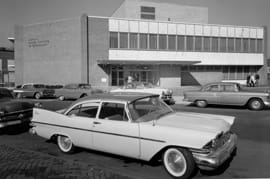Moments in Graduate Studies History

- Drexel Awarded $850K Grant from The Pew Charitable Trusts To Help Make Atwater Kent Collection Accessible to Public
- ‘Seeing Philadelphia,’ a Selection From the Atwater Kent Collection at Drexel University Goes on Display
- Drexel Course Lends a Hand to the Mütter Museum
- Fashion From the 1920s Roars Into Display for Drexel’s New Fox Historic Costume Collection Exhibition

This summer’s landing of the Mars rover Curiosity reminds us of an earlier era of space exploration, beginning with the launch of the Soviet satellite Sputnik in 1957. A significant milestone in Drexel history happened two years later with the 1959 opening of the new library (pictured here), one of the largest in the region. Perhaps the pronounced tailfins on the 1957 Plymouth Savoy (in contrast to the older automobiles parked outside the library) reflect the nation’s growing interest in aerospace. Certainly Drexel students and faculty were interested in the era’s new technologies, and eager to pursue research.
The post-war era of the late 1940s and 1950s saw a rapid increase in graduate enrollment at Drexel. Let’s look now at the dawn of the 1960s, when Drexel was, in the words of Professor Miriam Kotzin, “facing the atomic and space age” with a new focus on research.
The Soviet success at putting Sputnik in orbit shattered, Kotzin wrote, illusions of the United States’ “global technological supremacy.” Former Drexel president James Creese was less surprised than most, for just a year before, in the summer of 1956, he had been one of a select group of academics to visit the Soviet Union, touring universities, technical institutes and factories. He was impressed by the level of technological expertise of teachers and students, not just in Moscow but in the remote cities of the Soviet Union. Upon his return to Philadelphia, Creese reported his findings and was deluged with letters from academia and industry, asking him what was really going on behind the Iron Curtain. A vice-president at General Electric wrote to Creese to protest that the Soviets were educating three times as many scientific and technical graduate students as was the U.S.
By 1960, the faculty of the College of Engineering were engaged in a vigorous debate about whether or not to launch a full-time day graduate program in addition to the existing part-time evening program. The engineering faculty was transforming rapidly; the number of professors with the Ph.D. doubled in the five years from 1958-63. In the decade that followed, this trend would spread across Drexel, encouraged by new president W. W. Hagerty, who identified his top priority as “the establishment of graduate programs of the highest quality.” Only 25 percent of the faculty had doctoral degrees in 1963; 10 years later, that number skyrocketed to 70 percent. Hagerty noted in 1973 that Drexel had produced 152 PhDs in only five years, establishing “genuinely interdisciplinary and multidisciplinary programs… [including] biomedical engineering and environmental sciences.”
Today NASA is exploring Mars instead of the moon, and the newest cars have gas-electric hybrid engines instead of tailfins. Yet the pursuit of interdisciplinary research remains Drexel’s hallmark.
In This Article
Drexel News is produced by
University Marketing and Communications.